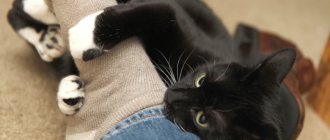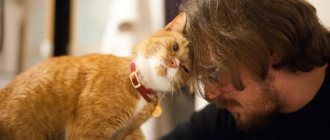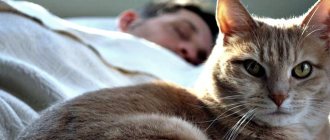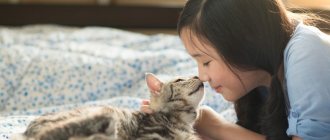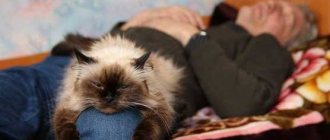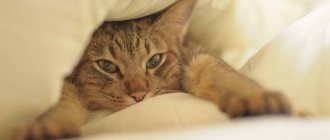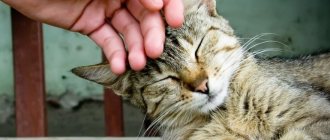Has your cat decided to express its opinion about your hairstyle?
Or maybe, at every opportunity, trying to prove to you that your hair could use a little makeover?
Here's a typical scenario:
you are sleeping when suddenly a strange feeling arises. You instinctively reach your head and feel that part of your hair is... wet. And next to him sits the culprit of this whole situation. A cat who looks at you with surprised eyes and then returns to the activity he previously performed with such passion: licking your hair. Feeling how wet your strands are, you begin to realize that he's been doing this for a long time. And then you wonder, “why is my cat licking the hair on my head?” Let's check what's behind this behavior.
The cat licks your hair because he likes you
- Veterinarians say that licking hair may be a cat's way of expressing its feelings.
- Mutual care is a common bonding behavior between cats. As the owner of at least two pets, you're probably used to seeing cats lick each other.
- In addition, mutual care may be the result of a revival of the maternal instinct. Although this explanation is not fully confirmed in reality. After all, this behavior is also observed in cats.
- Another theory is that this is a way for cats to relax themselves, reducing stress and tension.
Cats that bond very closely with their guardian may make the guardian the target of the above behavior. The focus will automatically be on areas with hair (for example, we have the most of it on our heads). This is completely normal, and if your cat is licking individual strands of hair, there is nothing to worry about. Give him your love and offer him a solid dose of affection. After all, he finally washed your hair.
Causes
A cat can lick the head of any family member for various reasons. The first, and most basic, is a natural craving for cleanliness. This way they are trying to show they care and show that they care about you.
Other reasons:
- The appearance of love. Just as a cat licks its newborn kitten, your pet will lick you too. This ritual, special for them, contains all the tenderness, love and care that only a cat can give you;
- Often, a cat licks the hair, hands or face of the owner in order to get something tasty. When he sees a treat in your hands, the pet shows all his tricks to get it;
- Craving for dominance. Sometimes, an animal wants to show who is boss in the house, and by licking a person, it shows its dominance. Like a mother who takes care of her child in every possible way, a cat shows care for its owner;
- If the cat is very constrained and tense while licking the hair, then this means that the owner completely dominates her. This is a direct signal of the pet feeling uncomfortable; he is tense all the time, and this can negatively affect the animal’s psychological and physical health;
- If your cat is licking the hair on its head, this may indicate that it is simply bored. The tailed friend lacks attention. If such impulses are constant, you should worry about the state of her psychological health and visit a specialist to fully examine and solve the problem;
- If a person has strong and pungent odors, the cat tries to rid him of them. Any cosmetics, perfumes, creams, ointments, and even sweat secretions are perceived harshly by the pet and, in their opinion, are dangerous. Therefore, by licking the owner, the animal wants to protect him and himself from the impending danger;
- Presence of diseases . It is worth examining the cat well, monitoring its behavior and possible accompanying symptoms. Excessive licking may indicate the presence of parasites, dermatitis, allergic reactions, skin irritations, rashes and various infections.
A cat licks a person's hair for its taste or smell.
- According to leading veterinarians, some cats may simply enjoy the taste of the shampoo and other hair products you use. However, if you use hairspray, hair mousse or other styling products, it is best not to let your cat lick your hair. After all, you don’t want him to consume chemicals contained in cosmetics - they can harm him.
- Moreover, the oil produced by the scalp may also seem tasty to pets. Some cats may also be fascinated by the texture of their fur.
Cat Care Basics
Cats have been grooming themselves for thousands of years to stay clean and healthy. Grooming serves several important functions for your pet. It helps keep the coat clean and dry.
This practice is also known to prevent external parasites from entering the fur and skin. When it's hot outside, extra grooming helps cats stay cool. Since they cannot sweat, the moisture on their skin evaporates, aiding in cooling.
The cat licks its owner's hair to mark territory
Whether you've been out all day or just popped into the nearest store, your cat will immediately pick up on the other scents you've picked up along the way. Your furry friend will want to take them off your “fur” so you smell like him. So now you belong to his “domain”. By licking, he marked you, thereby informing other cats (if you have more than one) to stay away from you.
Should you be alarmed when a cat licks a person?
It is immediately worth noting that the pet does not have any mental disorders. And just health problems too. The most plausible explanation for why cats lick humans is as an expression of affection. In addition, the animal tries to mark its owner and leave its scent on him. A pet cannot leave a mark in its usual way.
For defecation in the wrong place, a well-deserved punishment will immediately follow. It is easier for a cat to lick a person. In some cases, the procedure may not seem entirely pleasant. Purrs have a very rough tongue, unlike dogs. But over time you can get used to it. Do not push away or offend the animal.
In parallel with licking a person, a cat can knead him with his paws. This way he calms himself down. This behavior may be characteristic of animals that were weaned early from their mother's breast.
However, this does not explain why cats lick people, because they can knead and suck on a blanket or a stuffed animal. Such “dances” can continue for a long time and you should not pay attention to them.
If you still wonder why cats lick people, it’s worth remembering that their larger relatives live in prides. In addition, if there are several purrs in the house, you can often notice that they lick each other and at the same time chirp and enjoy themselves.
Most likely, if a cat licks a person, it means that she considers him a member of her family, shows care, and expresses tenderness. You shouldn’t constantly think about why cats lick people. There is nothing wrong!
How to stop this behavior?
- If you don't want your cat to lick your hair, try to discourage her from doing so.
- If you pet your cat or talk to him during this training ritual, you will let him know that you approve of this action.
- When your cat tries to lick your hair, let him know that you don't like it. Just get up and walk away from your pet.
- If you think your hair products may be causing you to become overly interested, change them to something else. Your hair may no longer be as attractive to your cat. Cats generally don't like the smell of citrus fruits, so you can try lemon-scented shampoos and body washes.
The reason why a cat licks a person
Most likely there is a bad smell coming from the owner. Purrs have a more developed sense of smell than humans. In addition, they are considered the cleanest animals on the planet. As a rule, they are attracted to the area under the arms. However, there is another explanation why a cat licks a person here.
She is attracted by the owner's natural scent. The animal can not only lick sweating areas, but also dirty clothes. This way it feels safe and expresses some gratitude.
Mostly a cat licks its human. An animal will not behave this way with strangers because it does not trust. It can rub against the legs and climb into the arms of guests. But not to everyone. Only to those who, in her opinion, are worthy of trust. Most of all, purrs prefer women. Most likely they feel that they can feed them. Animals do not trust children because they are too noisy and can offend them.
Kitten climbs into man's hair
When the kitten has eaten, played and is about to take a nap, the baby gets a special pleasure from playing with the owner’s hair. Fluffy hair reminds the pet of early infancy, when the cub associated warmth, food and protection with thick maternal fur.
Often the kitten instinctively buries itself and looks for a source of milk in its hair, since it is accustomed to doing this in the first weeks after birth. This behavior is especially characteristic of the smallest pets that have been separated from their mother. Until the kittens grow up enough and forget about breastfeeding, from time to time the babies will look for their mother's nipple.
The cat pulls out hair
When playing with hair, some cats can cause significant pain to a person (chewing, biting). How to break the habit? There is no need to encourage this behavior, otherwise the pet will get used to tormenting the owner in search of entertainment and games. Cats understand intonation well, so a sharp shout is usually enough to make the animal stop. If a verbal ban does not help, you need to quickly remove the naughty pet from the room. As soon as the cat understands that an attempt to pull hair is followed by confinement in solitude, the animal develops a conditioned reflex and further attempts at such play will stop.
Weaning a cat from the habit of licking its head
The habit of a cat licking a person's head is not pathological, but it can irritate the owner of the animal or family members. To change this behavior pattern, the following methods are recommended:
- interest your pet in outdoor games;
- take the cat in your arms and caress it, scratch its ears or belly;
- change the position of the body so that the cat cannot reach the head;
- take a pet brush and take care of your furry pet’s fur.
Why does a cat lick his hands?
Often our pets love to lick the hands of their owner, however, knowing that cats are not dogs, and they are very restrained in their feelings, most people begin to wonder why their pet behaves this way.
In fact, such behavior often does not really mean an expression of feelings, but is an ordinary instinct that the pet acquired from its mother, because cats lick their children at the very beginning of their lives. However, such behavior of an animal can be perceived as caring for the owner, so it can also be called a manifestation of love and devotion, which will be doubly pleasant for any owner of such a pet.
Why does a cat comb its owner's hair?
Contents hide
Tell me, have you now recognized yourself and your pet? Then, with a high degree of confidence, we can assume that your cat actively uses grooming as one of the main models of social behavior. What does this look like in practice? Something similar is often noticed by owners of several pets. When peace and harmony reign in the house, furry pets love to tidy each other up, lick each other, etc. Cats transfer this model of behavior to their owners, apparently considering them to be part of one big family. What is “licking” in a cat’s understanding? This is the transfer of one’s own scent, a kind of mark in the spirit of “you are only mine.” A large and friendly family, accordingly, should smell the same.
There are also some oddities. A pet can show a completely unexpected, sudden interest in the owner’s hair. And again it's about smells. So, he may “like” your new shampoo or other cosmetic product. Therefore, do not think that a great stylist is sleeping inside your pet. Consider cat care as a compliment: not every person is accepted into a cat family.
Perhaps some time ago you yourself unwittingly reinforced this behavior. It all happened by chance, during play or petting. The cat accidentally touched the hair, in response you encouraged it - stroked it or even gave it a treat. And they themselves did not pay attention to what happened. And the purr connected both of these events in her head and is now trying to please her owner.
But sometimes something pleasant doesn’t come out. The pet tangles its hair and sometimes starts sucking on it. How should we evaluate this behavior? Perhaps we are dealing with some echo of the stress suffered by the animal. In such a unique way, a cat seeks protection and consolation from its owner. Or your “purry” has developed the so-called “pica” - simply put, a perversion of taste. In the first case, try to find out whether the cat might have experienced severe fright or stress. If the matter is a perversion of taste, then, as a rule, the matter is not limited to hair alone - plastic bags, wool, paper, etc. are also used. Some breeds (Siamese, Burmese, Orientals, etc.), by the way, are more likely than others to tend to suck and chew inedible things and objects.
In any case, we do not recommend encouraging such behavior, and here’s why. Surely you have come across “wool balls” - when a cat regurgitates lumps of hair that got into the stomach after washing itself. Now imagine what happens when strands of human hair enter a cat's stomach.
Strictly speaking, taste perversion is a rather serious condition; your pet seriously risks its health. Just in case, be sure to consult your veterinarian.
Provide your pet with alternative options - for example, special soft toys work well. And don't rush to get upset. What if they finally gave you an exquisite compliment?
Based on materials from the publication : Why Do Some Cats Groom Their Owner's Hair? Author: Amy Shojai. Source: thesprucepets.com Photo: pixabay.com
Gray hair in cats
Representatives of the cat family can change color throughout their lives. Such changes can occur repeatedly (up to three times). This process is associated with hereditary factors and may resemble the appearance of gray hair in humans, especially if among the animal’s ancestors there were individuals with gray or smoky skin. Felinologists have coined the term “reblooming” to describe this phenomenon. The change in color is quite typical for black cats. In the early period of development, the color of the skin changes between ashy and brown, finally being determined when the pet reaches one and a half years.
Age-related changes in pigmentation are characteristic of all mammals. If the color of the coat changes sharply, over a short period of time, there is reason to worry and take your pet to the veterinarian.
In addition to color change, there are other reasons why a cat changes the shade of its coat. The color and density of wool is affected by seasonal temperature fluctuations. This effect is especially characteristic of Siamese, Burmese, and representatives of the Himalayan breed. In winter, these cats' fur becomes darker, and in the summer months it fades in the sun and becomes chocolate-colored. In some individuals, with age, a pattern appears on the skin in the form of strokes and lines, which was absent in youth. Such contours are drawn with whitened hairs.
Causes of graying
If the owner notices a change in the color of the pet’s fur, the following reasons for the origin of this phenomenon should be checked:
- Stressful condition. Some cats react painfully to the need to move from place to place or separation from family members. The appearance of a new pet can also serve as a source of anxiety, as can any change in the situation, perceived as a threat to the usual way of things.
- Complications after illness or surgery. Anesthesia, long-term use of medications, and allergic reactions lead to changes in the structure of the fur in certain areas of the body surface. After the body recovers, new hair will grow.
- Age-related changes. The average age of cats at which age-related graying becomes noticeable is 8 – 12 years. In general, the process of changing hair pigmentation is individual in nature. Some cats begin to change the color of their fur from the age of three, while other cats retain their charcoal color from birth until old age.
- Diet. The rich color of a cat's fur is ensured by the presence of melanin pigment in the fibers of the fur coat. A lack of trace elements, copper and amino acids that contribute to the production of this substance, can lead to the animal’s fur becoming dull and pale. In this case, the veterinarian prescribes a vitamin-mineral complex for the pet.
The appearance of gray hair in a cat is not associated with senility and does not portend imminent death. Hereditary factors can influence the discoloration of the fur coat. If the kitty retains all the signs of a healthy animal, does not lose hair, has a good appetite, a cheerful mood, and regular bowel movements, there is no reason to worry. If other alarming symptoms occur, you should take your furry pet for examination and consultation to a veterinary clinic.
